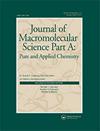Nanomolar detection of hypochlorite in ground water samples by a norbornene-based polymeric sensor via unusual fluorescence turn-on response
IF 2.4
3区 化学
Q3 POLYMER SCIENCE
Journal of Macromolecular Science Part A-Pure and Applied Chemistry
Pub Date : 2023-09-22
DOI:10.1080/10601325.2023.2257767
引用次数: 0
Abstract
AbstractHypochlorite anion has been widely used as a bleaching and disinfecting agent in daily life. Selective and sensitive identification ofOCl-ions from water is very important for researchers. For this purpose, monomeric (NPh), and polymeric (PNPh-Peg) novel fluorescent sensors have been established for the specific and excellently unique sensors that exhibit selective characteristics like excellent resistance to bleaching and a high fluorescence brightness. A multi-functional random polymer (PNPh-Peg) with ICT (intramolecular charge transfer) active para–amino phenol functionality and reactive oxygen species (ROS) responsive, PEG attached are readily prepared via ROMP (ring-opening metathesis polymerization).: An ICT-active random polymer (PNPh-Peg) exhibited an unexpectedly strong cyan blue emission in a water medium compared to that in other common organic solvents, which was dramatically increased by adding a trace amount of NaOCl.: Incorporating PEG moiety in the polymeric backbone increases the water solubility of a copolymer, and the ROS-responsive groups make the polymer a good ROS scavenger. Upon oxidation of the phenol group into carbonyl, both the monomeric (NPh) and polymeric (Norp-PEG oh) sensors showed a selective, noticeable, unusual fluorescence turn-on response towardsanalyteOCl-ions with a very fast response (within three minutes). The detection limit (59.14 nM) and (126.93 nM) were calculated for monomeric and polymeric sensors, respectively. This was a selective, specific oxidation reaction of the completely water-soluble random polymeric sensor (PNPh-Peg) for hypochlorite anions and can be applicable for quantitative measurement of aqueous OCl-. This ICT-active random polymeric molecule (PNPh-Peg) can also be used as a fluorescent sensor for unique OCl- detection from contaminated water by preparing a sensor-coated paper strip. Thus, these multi-functional monomeric (NPh) and polymeric (PNPh-Peg) sensors are anticipated to apply to the environment.Keywords: Bio-imagingbleaching propertyhygroscopicmulti-functionalpolymeric sensor AcknowledgmentsJ. S. thanks DBT for a research fellowship. R. S. thanks IISER-K, DBT, DST, and DRDO for funding. The authors thank IISER-K for the use of infrastructure and facilities.Authors’ contributionsJ.S. did all the reactions and wrote the manuscript. N.D. helps to do the reactions and write the manuscript. R.S. supervised every step of this project.Disclosure statementNo potential conflict of interest was reported by the author(s).基于降冰片烯的聚合物传感器通过异常荧光开启响应检测地下水样品中的次氯酸盐
摘要阴离子次氯酸盐在日常生活中被广泛用作漂白剂和消毒剂。选择性、灵敏地鉴别水中的氯离子对研究人员来说是非常重要的。为此,已经建立了单体(NPh)和聚合物(PNPh-Peg)新型荧光传感器,它们具有特异性和非常独特的传感器,具有优异的抗漂白性和高荧光亮度等选择性特性。通过开环复分解聚合制备了具有ICT(分子内电荷转移)活性对氨基酚官能团和活性氧(ROS)响应的多功能无规聚合物(PNPh-Peg)。与其他常见有机溶剂相比,ict活性无规聚合物(PNPh-Peg)在水介质中表现出意想不到的强烈的青色蓝色发射,通过添加微量的NaOCl显著增加。在聚合物主链中加入PEG片段增加了共聚物的水溶性,并且ROS响应基团使聚合物成为良好的ROS清除剂。在苯酚基团氧化成羰基后,单体(NPh)和聚合物(Norp-PEG oh)传感器对分析的氯离子表现出选择性的、明显的、不寻常的荧光开启反应,反应非常快(在三分钟内)。单体传感器和聚合物传感器的检出限分别为59.14 nM和126.93 nM。这是一种完全水溶性无规聚合物传感器(PNPh-Peg)对次氯酸阴离子的选择性、特异性氧化反应,可用于水溶液OCl-的定量测量。这种信通技术活性随机聚合物分子(PNPh-Peg)也可以用作荧光传感器,通过制备传感器涂层纸条,从受污染的水中进行独特的OCl检测。因此,这些多功能单体(NPh)和聚合物(PNPh-Peg)传感器有望应用于环境。关键词:生物成像;漂白性能;吸湿;感谢DBT提供的研究奖学金。r.s.感谢IISER-K, DBT, DST和DRDO的资助。作者感谢IISER-K使用了基础设施和设施。作者的contributionsJ.S。做了所有的反应并写了手稿。N.D.帮助做反应和写手稿。R.S.监督了这个项目的每一步。披露声明作者未报告潜在的利益冲突。
本文章由计算机程序翻译,如有差异,请以英文原文为准。
求助全文
约1分钟内获得全文
求助全文
来源期刊
CiteScore
4.60
自引率
16.00%
发文量
61
审稿时长
3.1 months
期刊介绍:
Journal of Macromolecular Science, Part A: Pure and Applied Chemistry (JMS-PAC) is a necessary resource for academic and industrial scientists and engineers whose interests center on both synthetic and naturally occurring polymers and their applications.

 求助内容:
求助内容: 应助结果提醒方式:
应助结果提醒方式:


